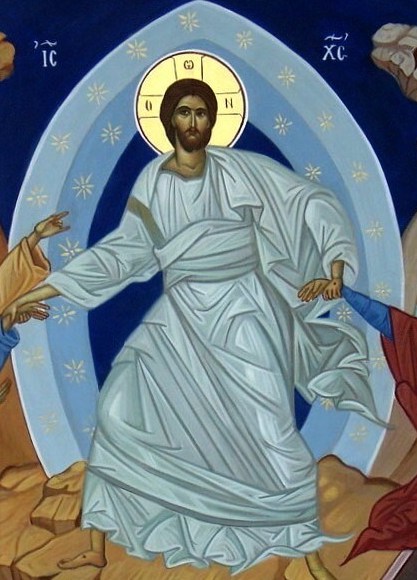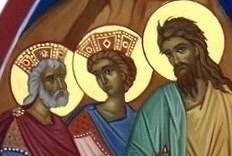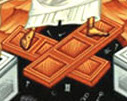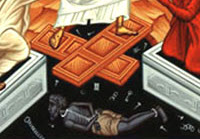Christ is risen! Truly He is risen!
As we exchange this joyous greeting through Pentecost, celebrating Jesus’ triumph over death, let’s take a fresh look at the icon of the Resurrection.
![]()
This beloved icon, also known as “Christ’s Descent into Hades” or “Anastasis,” is a wonderful example of “theology in color” because of the depth of instruction it contains. As writer Jeremiah explains in his blog Orthodox Road: Rediscovering the Beauty of Ancient Christianity, “One of the key things to remember is that icons are not meant to be ‘photo recordings’ of what happened. These are symbolic tools that assist us in comprehension of the gospel truth through our sense of sight.”
Thus this icon celebrates the fullness of what Jesus accomplished, beyond bodily rising from the grave: “The Orthodox Icon of the Resurrection is not content with simply showing us the Risen Christ, or the empty tomb; the Victory shown in the Icon of the Resurrection is complete” (A Reader’s Guide to Orthodox Icons).
The Depiction of Our Risen Lord
Jesus, of course, takes center stage, victoriously robed in heavenly white.

In some versions of this icon, His robe seems almost in motion, flowing upward, symbolizing His descent into Hades to save those who have died since the beginning of human history.

Notice the bluish oval that surrounds Him, often studded with stars. This is a mandorla (Italian for almond, which describes its shape). The mandorla represents the uncreated, eternal light of Christ. As blogger Jeremiah explains, “This is not simply a pretty, bright light. It is the same light which filled the apostles with wonder when they witnessed His Transfiguration. It is the light which Christ Himself described as the power of the Kingdom of God (Mark 9:1, Matt. 16:28, Luke 9:27). It is the light that filled the once perpetual darkness of Hades when Christ descended and brought life into the realm of death. It is also the light that is seen when one purifies their heart and mind (Blessed are the pure in heart, for they shall see God.)”
As you examine the mandorla, you will see that it becomes a darker blue as it moves toward Christ at its center. At first, this traditional usage of blue seems like an odd choice. But the light depicted is not sunlight, which is localized and casts shadows. It is the uncreated, omnipresent light of God. Also, as Jeremiah writes, “those who seek God will find that the more they know Him, the less they comprehend Him. To know God, to experience Him, is to walk in the darkness of His light, to enter into the mystery of His presence.”
Adam and Eve Released
![]()
Christ is sometimes shown holding a cross or a scroll, representing the message that He preached to the captives in Hades.
But in every Resurrection icon He is shown pulling an old man from the tomb. This figure is Adam, the first man, illustrating that Christ’s victory redeems all of humankind from the beginning. On Jesus’ left is Eve, and He is often shown pulling her from the tomb also.

But in other versions of the icon, Eve holds her hands out in supplication, waiting for Jesus to act. His rescue of Adam and Eve also foreshadows the general resurrection of the body before the Final Judgment.

Significantly, Jesus does not hold Adam’s and Eve’s hands. Instead, He grasps them by the wrist, signifying that “we are not equal with God. We cannot even meet God halfway. But if we reach out to God, He is ready to grasp us by the wrist to take us with Him to Paradise. This is the most hopeful part of the icon. It reminds us that we have to reach out to God in faith, and let Him take care of the rest” (Fr. Stavros, “The Icon of the Resurrection”).
Thou didst descend into the tomb, O Immortal,
Thou didst destroy the power of death!
In victory didst Thou arise, O Christ God,
…bestowing resurrection to the fallen.
— Paschal Kontakion
Figures Surrounding Jesus

Other captives stand on either side of Jesus. On the left (at Jesus’ right) stand John the Baptist and two Old Testament figures from Jesus’ earthly lineage: King David and King Solomon. Their presence signifies that those who died before Jesus’ Crucifixion descended to Hades and patiently awaited their Messiah. But now Jesus has freed them to join Him and His angels.

The figures on the right vary from one icon to another but usually represent Old Testament prophets. The young man with the shepherd’s crook is Abel, the first person to die as a result of the Fall (murdered by his brother, Cain). Some icons also include the three young men who were thrown into the fiery furnace in Daniel 3. (They are at the top of this grouping.)
Hades Defeated

Beneath Jesus’ nail-scarred feet—notice that His feet and hands still carry the marks of His crucifixion—lie two gold bars, often in the shape of a cross. These are the gates of Hades, which He has broken open. The icon proclaims visually the words of the Paschal hymn: Christ has trampled death by His own death.
In the darkness below His feet, Hades is shown in chaos after Jesus descended and liberated the captives in the “harrowing of Hades.” The word harrow comes from an Old English word used to describe the plowing of a field when the cultivator churns up the earth.

Most Resurrection icons show keys, chains, and locks scattered in the darkness, because the power of death to bind humanity has been destroyed. And in the depths of the pit, a skeletal being is sometimes shown, lying prostrate and bound up. This is Hades personified—Death and/or Satan, who has been destroyed and defeated by Christ, illustrating the truth of Hebrews 2:14, that “through death he might destroy him who has the power of death, that is, the devil.” Our Savior’s death brings life to all.
Christ is risen from the dead,
Trampling down death by death,
And upon those in the tombs bestowing life!
— Paschal Hymn
May the truths written into this beautiful icon bring you joy during Bright Week and throughout the year. Now go and celebrate Jesus’ victory over death with barbecue and all kinds of cheesy goodness!
Thank you for this exposition!
Indeed He is Risen!! Apr 28 2020
What a blessing to read your writing archives!! Just me AT 😉
Thank you, Andrea!
Thank you for the beautiful explanation. One question though in most resurrection icons, Adams sleeves have different colors, for example left sleeve is dark blue and right is golden or white. Any explanation?. Thank you for your valuable time.
I had never noticed that! I took another look at my Resurrection icon, and the right sleeve of Adam’s green robe is blue. It’s not a coincidence that this is the arm that Christ is touching. I looked it up, and the color change shows that Adam is already beginning to be transformed. In some icons, Christ is grasping both Adam’s and Eve’s arms, and those sleeves will always show a color change. Thanks for pointing this out!
Thank you so much for the quick response. It make sense that the resurrected status is transforming to the heavenly status as St. Paul points that in the letter to Corinthians.
Thanks again,
Regards,
John